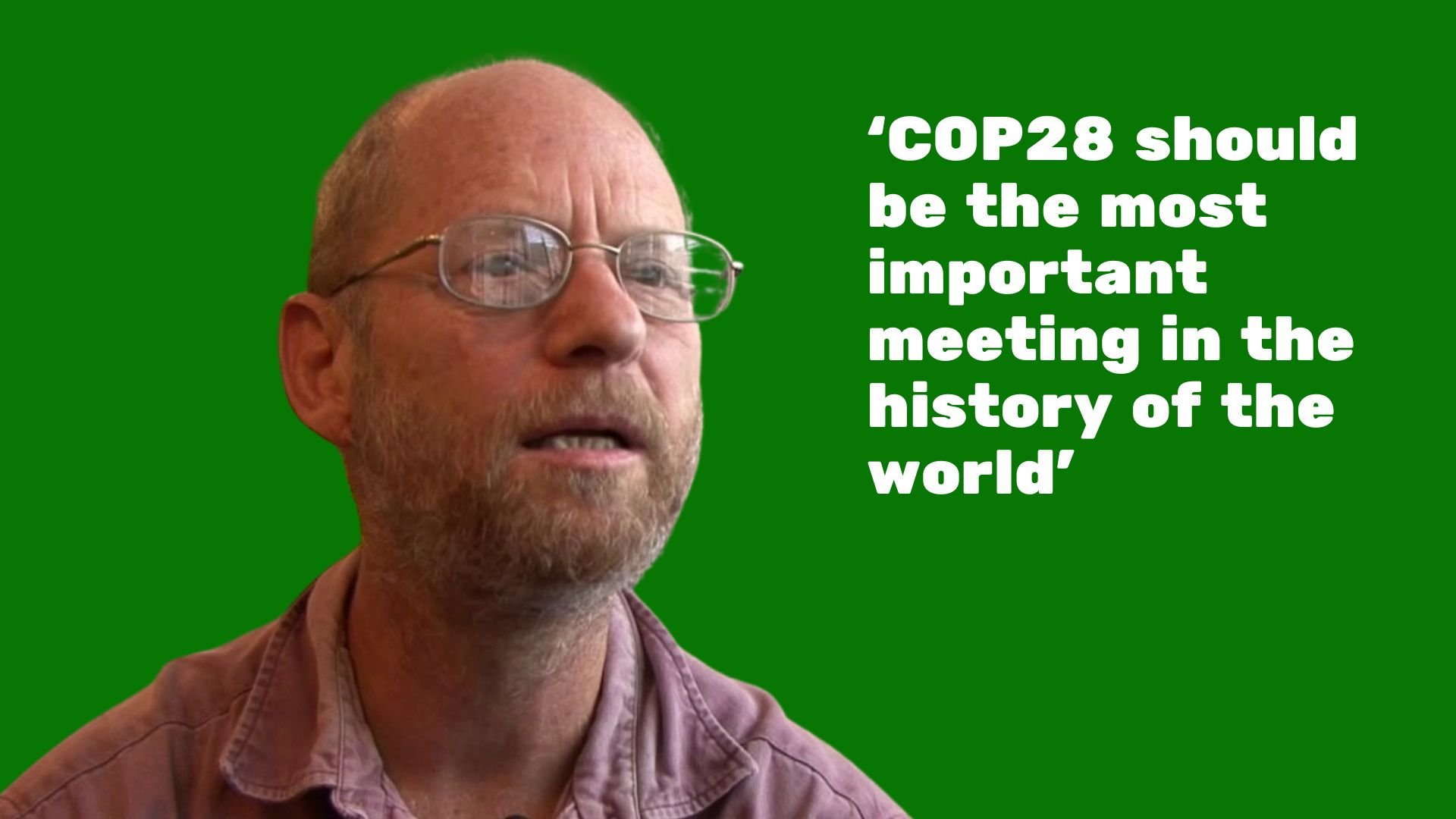 British journalist DAVID HILL interviewed Jeremy Brecher in the lead-up to COP28 about why international climate negotiations fail and how a “global nonviolent constitutional insurgency” could be a climate game-changer.
British journalist DAVID HILL interviewed Jeremy Brecher in the lead-up to COP28 about why international climate negotiations fail and how a “global nonviolent constitutional insurgency” could be a climate game-changer.
DH: Last year when we were in touch you said you thought COP27 “should be the most important meeting in the history of the world – nothing could be more important than international agreement to meet the climate targets laid out by climate science and agreed to by the world’s governments at the Paris Climate Summit.” Do you feel the same about COP28?
JB: Of course, COP28 should be the most important meeting in the history of the world. That was also true of COP27, COP26 and all the previous COP climate meetings. While they should be producing international agreement to rapidly reduce greenhouse gas (GHG) emissions to zero, the reality is that the decades of international climate conferences have simply legitimated ever rising GHG emissions and ever increasing climate destruction. The idea that it is being hosted by Dubai and chaired by Sultan Ahmed al-Jaber, the head of the United Arab Emirates’s state-owned oil company, represents the height of absurdity – like putting Al Capone in charge of alcohol regulation. Sultan al-Jaber’s letter laying out plans for COP 28 is lacking in ambition to reduce climate destruction. The entire so-called international climate protection process is now controlled by those who hope to gain by climate destruction. A global nonviolent insurgency against the domination of the fossil fuel industry and the governments it controls appears to be the only practical means to counter their plan to destroy humanity.
DH: In other words, COP28 should be the most important meeting in the history of the world, but it’s not going to be. What do you think is the percentage chance of an international agreement to phase out fossil fuels being reached?
JB: The answer to this one is easy: there is zero chance that COP28 will produce an agreement that will actually phase out fossil fuels. The forces that are in control of the governments represented in COP28 represent fossil fuel interests that are intent on continuing and if possible expanding their use. US President Eisenhower once said that the people wanted peace so much that some day the governments would have to get out of their way and let them have it. An international agreement that will actually phase out fossil fuels will come when governments discover that if they want to go on governing they have to let the people have climate safety.
DH: As I understand it, we were very close in the late 1980s when, according to US author Nathaniel Rich, in his book Losing Earth, “the world’s major powers came within several signatures of endorsing a binding framework to reduce carbon emissions – far closer than we’ve come since.” Why do you think we’ve been treading water or going backwards after that?
JB: In the late 1980s concern with global warming burgeoned. GHG emissions threatened the climate, but a relatively modest rate of GHG reduction could have limited most of the threat. There was widespread support for action to do so. But by the time of the first COP [held in Germany in 1995], the oil, auto, and many other allied industries had organized a powerful coalition to oppose any mandatory restrictions in fossil fuel use. They directly borrowed the tactics that had been used so successfully by the tobacco industry to block regulation, and spent millions to discredit climate science, generally not trying to refute it directly but to cast doubt on its findings, saying they were uncertain. And they portrayed climate protection policies as a threat to the economy and specifically to workers’ jobs. Fossil fuel workers became the “poster children” for the alleged threat of climate protection policies.
DH: What about the US’s role in particular?
JB: While there remained strong international support for GHG reduction measures, from the time of the Kyoto COP onwards the US opposed any serious mandatory limits on fossil fuel production and use. The power of the US made international agreement impossible – and other countries were often willing to hide behind US intransigence to “talk the climate talk” but not “walk the climate walk.” As the rate of GHG emissions grew year by year, and the amount of fossil fuel use reduction that would be necessary to protect the climate therefore grew year by year, the scale and cost of climate protection became increasingly daunting. Instead of rallying to meet the problem, the world’s governments have adopted a series of subterfuges – carbon trading, carbon capture and the like – designed to give the appearance of addressing the problem while actually increasing GHGs with each international meeting and agreement supposedly designed to reduce them.
DH: Just to come back to something you said earlier about how an international agreement phasing out fossil fuels will only “come when governments discover that if they want to go on governing they have to let the people have climate safety.” You seem to be implying you think an agreement will come one day. Is that right?
JB: Climate change has brought the world order to and past breaking point. It interacts with the proliferation of wars, the breakdown of democracy, the increase of poverty and inequality, the inability to contain pandemics, and the rise of global economic warfare. These interacting crises have been well characterized as a “polycrisis,” a breakdown of world order in which each crisis exacerbates the others. Prediction is difficult, but there is at least the possibility that at some point system breakdown will generate global popular and even elite pressure to address the polycrisis. That will require something along the lines of a “Global Green New Deal” which achieves a rapid managed decline of fossil fuel burning through measures designed to also expand jobs and justice globally. International agreements will be part of the infrastructure needed to support such a transformation, but they are likely to follow from power shifts that change the equation for the participating governments. In the meantime, a “coalition of the willing” composed of states and popular movements can begin creating their own transnational Green New Deal and move to isolate and pressure the “coalition of the unwilling.”
DH: When you talk about a “coalition of the willing”, or a “global nonviolent insurgency”, who are you thinking of exactly?
JB: With few exceptions, the governments of the world are all complicit – indeed, major protagonists – in the destruction of the climate, and with it humanity and their own people. Their rule is therefore fundamentally illegitimate – a violation of the fundamental constitutional principles that they claim legitimate their authority. On that basis, I have advocated a “global nonviolent constitutional insurgency” to enforce climate protection. An insurgency is generally defined as a movement that refuses to accept the legitimacy of an established government. While insurgencies are often armed and violent, there are also nonviolent ones. They draw on the techniques of nonviolent direct action – mobilizing populations to resist tyranny and oppression through demonstrations, occupations, strikes, general strikes, and other forms of nonviolent resistance. They express the withdrawal of consent from existing institutions. They can be powerful and effective because ultimately the power of rulers depends on the cooperation – or at least acquiescence – of those they rule.
DH: That can feel hard to accept sometimes, but I agree with you.
JB: Some insurgencies, while they deny the legitimacy of existing governments, do so in the name of enforcing fundamental constitutional principles that are being usurped by those currently in power. The climate insurgency is based on the argument made by US Judge Ann Aiken in the Juliana case that “the right to a climate system capable of sustaining human life is fundamental to a free and ordered society.” Governmental complicity with climate destruction therefore violates our fundamental constitutional right to a “climate system capable of sustaining human life.” Our nonviolent insurgency is our effort to enforce that right. The crime of climate destruction is going on in every country in the world and is pampered by international climate agreements that authorize climate destruction under the guise of climate protection. For that reason, a climate insurgency must be global, directed not only against individual governments, but also against the international system or world order that is perpetuating and legitimating climate destruction.
DH: And what kind of strategies are you envisaging?
JB: While there is a great deal to say about strategy for the climate insurgency, the core is to undermine the legitimacy of and consent to governments’ complicity with climate destruction. That effort is, of course, under way in myriad forms around the world through mass movements and civil disobedience. The idea of a global nonviolent constitutional insurgency is primarily a means to link them together, legitimate them, and make clear how and why they can be powerful.
DH: My penultimate question: What would you say to someone in, say, the UK, or perhaps other “western” countries, who is concerned about climate change and interested in trying to make a concrete, positive difference? What recommendations might you have for joining this “insurgency”, as you call it?
JB: Creating any social movement, insurgent or otherwise, requires that people recognize problems they have in common and reach out to each other to share their common concerns and start looking for common solutions. For individuals who are concerned about climate catastrophe, there are two crucial ways to do this. First, start talking with your family, friends, neighbours, workmates and anyone else you interact with. Let them know about your fears and concerns – even if it is a little uncomfortable or impolite to do so. You can tell them you don’t have all the answers, but you’d like to be part of a process in which people stop pretending the climate threat doesn’t really matter and start addressing it forthrightly. Second, start connecting with some of the many organized groups that are fighting to protect the climate. You can start with what is relatively easy: people in your community or city whose style and mode of action you are relatively comfortable with. Start going to their meetings and demonstrations. Offer to volunteer in their activities. Serve on a committee or as a neighbourhood representative. Recruit others you know to participate as well. There are many organized groups concerned about climate change, each with their own history, constituency and ideology. They don’t need to eliminate their differences, but they do need to work together for concrete results.
DH: And how can groups like these come together in a global sense?
JB: Here are four ways organized groups can transform themselves into cooperators in a global nonviolent constitutional insurgency. First, use the techniques of mass movement and nonviolent direct action to challenge and isolate the forces perpetrating climate destruction. This means bringing out their climate destroying programs and actions in ways that increase your support in the wider population.
DH: Second. . .
JB: Second, assert the fundamental illegitimacy of the governments and institutions that are perpetuating climate production. Explain why their patterns of behaviour violate the most basic of legal and constitutional norms. When they claim civil disobeyers are violating the law, turn the tables and explain why they are the ones who are violating the most fundamental laws underlying all government and indeed human survival.
DH: And third?
JB: Third, define your movement not just as a movement within the political arena of your own country, but as part of a global movement in which people from every country join to impose climate protection on all governments. When opportunities allow, reach out to coordinate with climate protectors in other countries around the world. Finally, develop alternatives to the plans of the fossil fuel advocates that fulfill the needs of those who are hurt by their policies. Create approaches where people understand that, far from having to choose between climate protection and personal wellbeing, climate protection can also be a way of advancing their personal wellbeing. These alternatives have found expression at local, national, and global levels in the principles of the Green New Deal, which lay out pathways for protecting the climate that simultaneously counter injustice and provide for sustainable livelihoods.
DH: Final, final question: So, will you, personally, be paying attention to COP28 at all?
JB: I try to keep abreast of climate news without going into the weeds on most current events. I am always alert to possible “game changers”, whether they be new impacts of climate change or new developments in the movements fighting it. So I will be keeping an eye on the news from COP28, but will only engage in depth if there seem to be things that will affect – positively or negatively – the opportunities and strategies for effective action by the climate protection movement.
DH: Jeremy, thank you so much.

